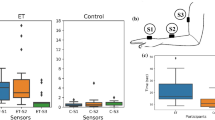Abstract
The measurement of body and limb posture is important to many clinical and research studies. Current approaches either directly measure posture (e.g., using optical or magnetic methods) or more indirectly measure it by integrating changes over time (e.g., using gyroscopes and/or accelerometers). Here, we introduce a way of estimating posture from movements without requiring integration over time and the resulting complications. We show how the almost imperceptible tremor of the hand is affected by posture in an intuitive way and therefore can be used to estimate the posture of the arm. We recorded postures and tremor of the arms of volunteers. By using only the minor axis in the covariance of hand tremor, we could estimate the angle of the forearm with a standard deviation of about 4° when the subject’s elbow is resting on a table and about 10° when it is off the table. This technique can also be applied as a post hoc analysis on other hand-position data sets to extract posture. This new method allows the estimation of body posture from tremor, is complementary to other techniques, and so can become a useful tool for future research and clinical applications.






Similar content being viewed by others
References
Aggarwal JK, Cai Q (1999) Human motion analysis: a review. Comput Vis Image Underst 73(3):428–440
Bhidayasiri R (2005) Differential diagnosis of common tremor syndromes. Postgrad Med J 81(962):756–762
Desmurget M, Prablanc C, Rossetti Y, Arzi M, Paulignan Y, Urquizar C, Mignot JC (1995) Postural and synergic control for three-dimensional movements of reaching and grasping. J Neurophysiol 74(2):905–910
Deuschl G, Raethjen J, Lindemann M, Krack P (2001) The pathophysiology of tremor. Muscle Nerve 24(6):716
Flash T, Mussa-Ivaldi F (1990) Human arm stiffness characteristics during the maintenance of posture. Exp Brain Res 82(2):315–326
Foxlin E (2002) Motion tracking requirements and technologies. In: Stanney K (ed) Handbook of virtual environment technology. Lawrence Erlbaum Associates, Mahwah
Gallagher A, Matsuoka Y, Ang W (2004) An efficient real-time human posture tracking algorithm using low-cost inertial and magnetic sensors. In: IEEE/RSJ international conference on intelligent robots and systems, Sendai
Hallett M (1998) Overview of human tremor physiology. Mov Disord 13(3):43–48
Kirsch RF, Boskov D, Rymer WZ (1994) Muscle-stiffness during transient and continuous movements of cat muscle—perturbation characteristics and physiological relevance. IEEE Trans biomed Eng 41(8):758–770
Kutch JJ, Kuo AD, Bloch AM, Rymer WZ (2008) Endpoint force fluctuations reveal flexible rather than synergistic patterns of muscle cooperation. J Neurophysiol 100(5):2455–2471
Latash ML (1992) Independent control of joint stiffness in the framework of the equilibrium-point hypothesis. Biol Cybern 67(4):377–384
Marsden CD (1984) Origins of normal and pathologic tremor. In: Findley LJ, Capildeo R (eds) Movement disorders: tremor, Macmillan, London, pp 37–84
Mason CR, Gomez JE, Ebner TJ (2001) Hand synergies during reach-to-grasp. J Neurophysiol 86(6):2896–2910
Miller N, Jenkins O, Kallmann M, Mataric M (2004) Motion capture from inertial sensing for untethered humanoid teleoperation. In IEEE-RAS International Conference on Humanoid Robotics (Humanoids), Santa Monica
Moeslund T, Hilton A, Krüger V (2006) A survey of advances in vision-based human motion capture and analysis. Comput Vis Image Underst 104(2–3):90–126
Murphy SL (2009) Review of physical activity measurement using accelerometers in older adults: considerations for research design and conduct. Prev Med 48(2):108–114
Mussa-Ivaldi FA, Hogan N, Bizzi E (1985) Neural, mechanical, and geometric factors subserving arm posture in humans. J Neurosci 5(10):2732–2743
Nishikawa KC, Murray ST, Flanders M (1999) Do arm postures vary with the speed of reaching? J Neurophysiol 81(5):2582–2586
Pentland A (2005) Healthwear: medical technology becomes wearable. Stud Health Technol Inform 118:55–65
Rochat P (1992) Self-sitting and reaching in 5- to 8-month-old infants: The impact of posture and its development on early eye-hand coordination. J Mot Behav 24(2):210–220
Rolland J, Baillot Y, Goon A (2001) A survey of tracking technology for virtual environments. In: Barfield W, Caudell T (eds) Fundamentals of wearable computers and augumented reality, chap. 3, Lawrence Erlbaum Assoc, Mahwah, pp 67–112
Scott SH, Kalaska JF (1995) Changes in motor cortex activity during reaching movements with similar hand paths but different arm postures. J Neurophysiol 73(6):2563–2567
Sergio LE, Kalaska JF (2003) Systematic changes in motor cortex cell activity with arm posture during directional isometric force generation. J Neurophysiol 89(1):212–228. doi:10.1152/jn.00016.2002
Sung M, Marci C, Pentland A (2005) Wearable feedback systems for rehabilitation. J Neuroeng Rehabil 2(1):17
Venkatraman S, Long J, Pister K, Carmena J (2007) Wireless inertial sensors for monitoring animal behavior, p 378
Vlasic D, Adelsberger R, Vannucci G, Barnwell J, Gross M, Matusik W, Popovi J (2007) Practical motion capture in everyday surroundings. ACM Trans Graph 26(3):35
Wade P, Gresty M, Findley L (1982) A normative study of postural tremor of the hand. Arch Neurol 39(6):358
Wang L, Hu W, Tan T (2003) Recent developments in human motion analysis. Pattern Recogn 36(3):585–601
Watanabe K, Ohtsuki T (1978) The effect of posture on the running speed of skiing. Ergonomics 21(12):987–998
Acknowledgments
We thank the National Institutes of Health (grants R01NS057814, 1R01NS063399 and 2P01NS044393) and the Chicago Community Trust for their financial support.
Author information
Authors and Affiliations
Corresponding author
Rights and permissions
About this article
Cite this article
Albert, M.V., Kording, K.P. Determining posture from physiological tremor. Exp Brain Res 215, 247–255 (2011). https://doi.org/10.1007/s00221-011-2889-3
Received:
Accepted:
Published:
Issue Date:
DOI: https://doi.org/10.1007/s00221-011-2889-3




